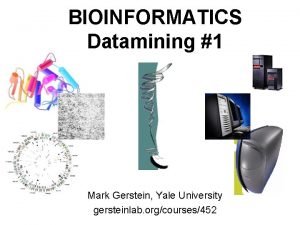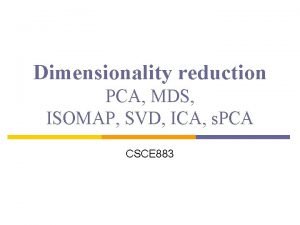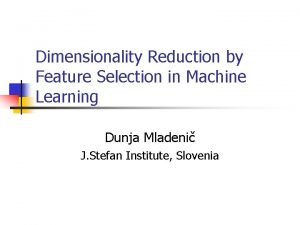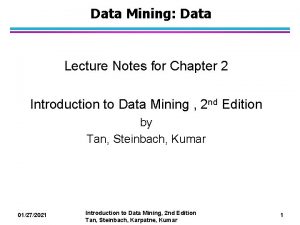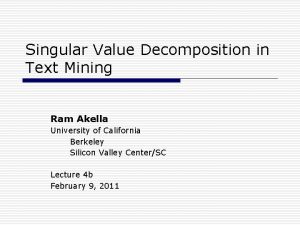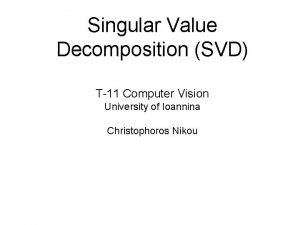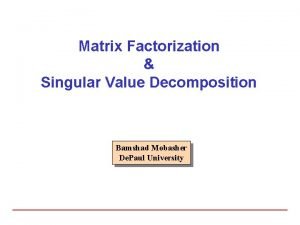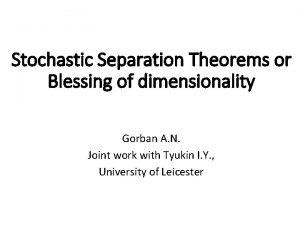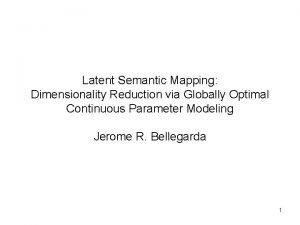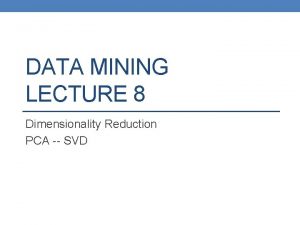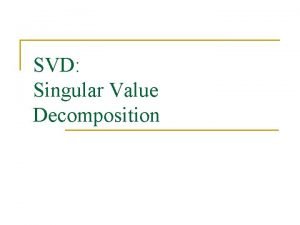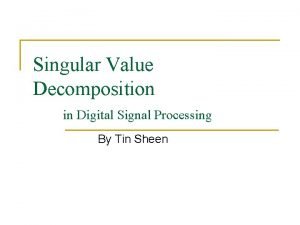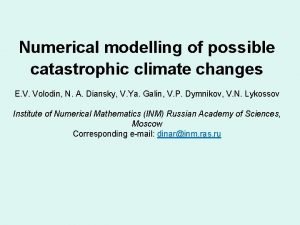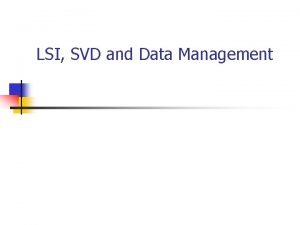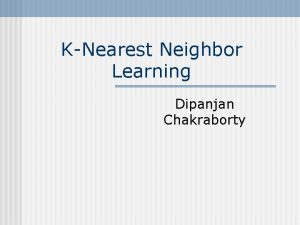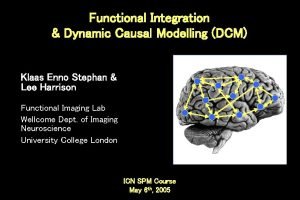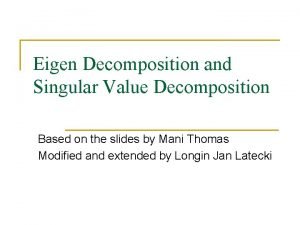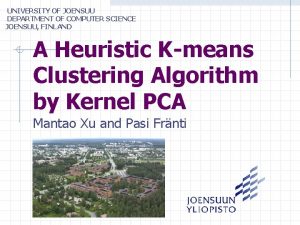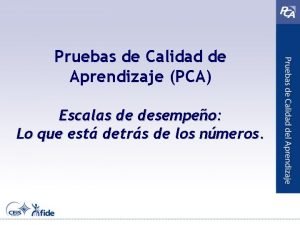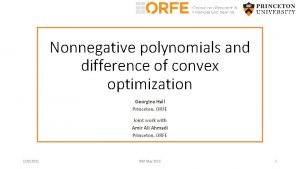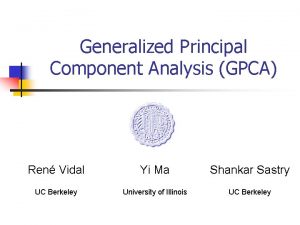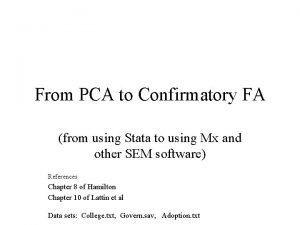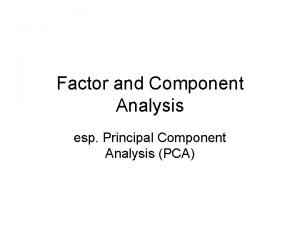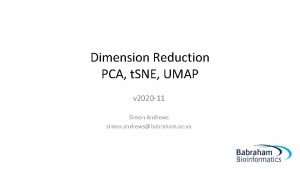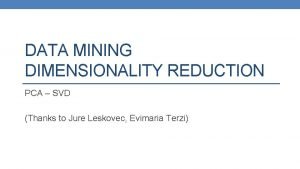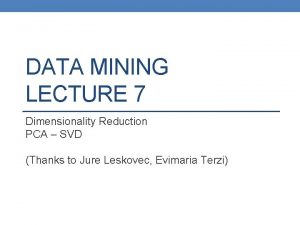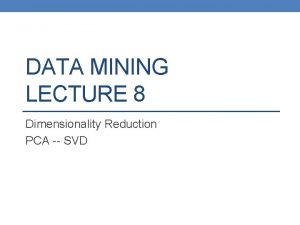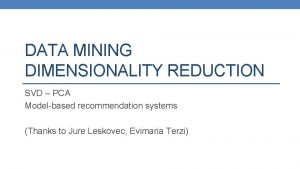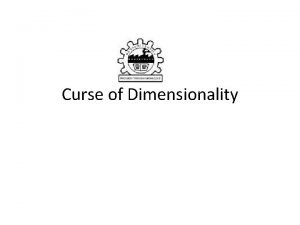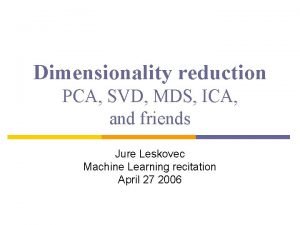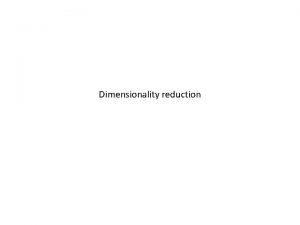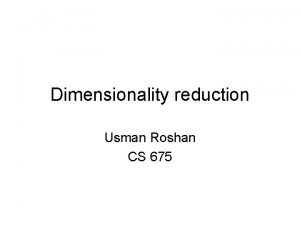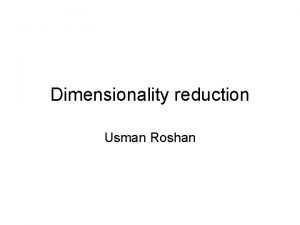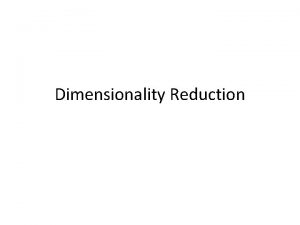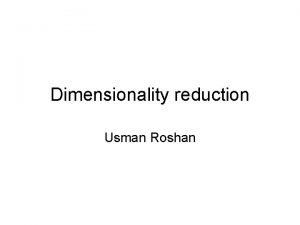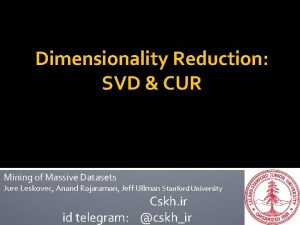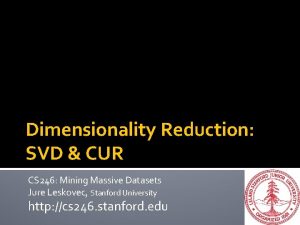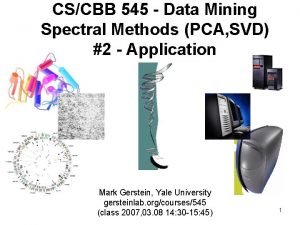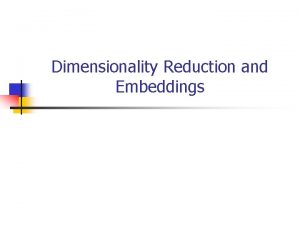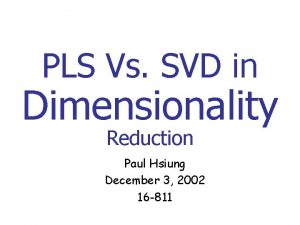DATA MINING DIMENSIONALITY REDUCTION PCA SVD Thanks to

















![Singular Value Decomposition • [n×m] = [n×r] [r×m] r: rank of matrix A Singular Value Decomposition • [n×m] = [n×r] [r×m] r: rank of matrix A](https://slidetodoc.com/presentation_image_h2/9123e5744e5fc4f8275a855a3755083c/image-18.jpg)





















































- Slides: 71

DATA MINING DIMENSIONALITY REDUCTION PCA – SVD (Thanks to Jure Leskovec, Evimaria Terzi)

The curse of dimensionality • Real data usually have thousands, or millions of dimensions • E. g. , web documents, where the dimensionality is the vocabulary of words • Facebook graph, where the dimensionality is the number of users • Huge number of dimensions causes problems • Data becomes very sparse, some algorithms become meaningless (e. g. density-based clustering) • The complexity of several algorithms depends on the dimensionality and they become infeasible (e. g. nearest neighbor search).

Dimensionality Reduction • Usually the data can be described with fewer dimensions, without losing much of the information in the data. • The data reside in a space of lower dimensionality

Example • In this data matrix the dimension is essentially 3 • There are three types of products and three types of users

J. Leskovec, A. Rajaraman, J. Ullman: Mining of Massive Datasets, http: //www. mmds. org Example • Cloud of points 3 D space: • Think of point positions as a matrix: 1 row per point: A B C • We can rewrite coordinates more efficiently! • Old basis vectors: [1 0 0] [0 1 0] [0 0 1] • New basis vectors: [1 2 1] [-2 -3 1] • Then A has new coordinates: [1 0]. B: [0 1], C: [1 -1] • Notice: We reduced the number of coordinates! A 5

Dimensionality Reduction • Find the “true dimension” of the data • In reality, things are never as clear and simple as in this example, but we can still reduce the dimension. • Essentially, we assume that some of the data is useful signal and some data is noise, and that we can approximate the useful part with a lower dimensionality space. • Dimensionality reduction does not just reduce the amount of data, it often brings out the useful part of the data

J. Leskovec, A. Rajaraman, J. Ullman: Mining of Massive Datasets, http: //www. mmds. org Dimensionality Reduction • Goal of dimensionality reduction is to discover the axis of data! Rather than representing every point with 2 coordinates we represent each point with 1 coordinate (corresponding to the position of the point on the red line). By doing this we incur a bit of error as the points do not exactly lie on the line 7

J. Leskovec, A. Rajaraman, J. Ullman: Mining of Massive Datasets, http: //www. mmds. org Why Reduce Dimensions? • Discover hidden correlations/topics • E. g. , in documents, words that occur commonly together • Remove redundant and noisy features • E. g. , in documents, not all words are useful • Interpretation and visualization • Easier storage and processing of the data 8

Data in the form of a matrix •

Example: Document matrices d terms (e. g. , theorem, proof, etc. ) n documents Aij = frequency of the j-th term in the i-th document Find subsets of terms that bring documents together

Example: Recommendation systems d movies n customers Aij = rating of j-th product by the i-th customer Find subsets of movies that capture the behavior or the customers

Linear algebra •

Matrices •

Change of basis •

Rank •

Rank-1 matrices •

Eigenvectors •
![Singular Value Decomposition nm nr rm r rank of matrix A Singular Value Decomposition • [n×m] = [n×r] [r×m] r: rank of matrix A](https://slidetodoc.com/presentation_image_h2/9123e5744e5fc4f8275a855a3755083c/image-18.jpg)
Singular Value Decomposition • [n×m] = [n×r] [r×m] r: rank of matrix A

Singular Value Decomposition •

Symmetric matrices •

Singular Values and Eigenvalues •

SVD properties • Singular Value Decomposition has three useful properties that we will study now: • It provides the important (principal) directions (dimensions) in the data – Principal Component Analysis • It provides the best low rank approximation for our matrix • It minimizes the reconstruction error (squared distance between real data points and their estimates)

Principal Component Analysis • Goal: reduce the dimensionality while preserving the “information in the data”. • In the new space we want to: • Maximize the amount of information • Minimize redundancy – remove the redundant dimensions • Minimize the noise in the data.

Variability •

Example • In the data below the data are essentially one-dimensional, but what is the axis we should use? • The direction in which the variance is maximized. The variance along the direction orthogonal to the main direction is small and captures the noise in the data

Example • Which direction is best to project? • Note that in the case of blue and green directions we have points that are far falling on each other. • The red maximizes the variance, which gives more information

Covariance matrix •

PCA: Principal Component Analysis •

PCA and SVD •

PCA Input: 2 -d dimensional points Output: 2 nd (right) singular vector 1 st (right) singular vector: direction of maximal variance, 2 nd (right) singular vector: direction of maximal variance, after removing the projection of the data along the first singular vector.

Singular values 2 nd (right) singular vector 1: measures data variance along the first singular vector. 1 1 st (right) singular vector 2: measures how much of the data variance is explained by the second singular vector.

Singular values tell us something about the variance •

SVD and Rank-k approximations A = U VT features objects noise = significant noise

Rank-k approximations (Ak) nxd nxk kxd Ak is the best approximation of A

SVD as an optimization •

What does this mean? •

Latent factor model • Rows (columns) are linear combinations of k latent factors • E. g. , in our extreme document example there are two factors • Some noise is added to this rank-k matrix resulting in higher rank • SVD retrieves the latent factors (hopefully).

An (extreme) example • A=

J. Leskovec, A. Rajaraman, J. Ullman: Mining of Massive Datasets, http: //www. mmds. org SVD – Example: Users-to-Movies Serenity Casablanca Amelie Romance Alien Sci. Fi Matrix • A = U VT - example: Users to Movies 1 3 4 5 0 0 0 0 4 5 2 0 0 4 5 2 n = m U VT “Concepts” AKA Latent dimensions AKA Latent factors 41

J. Leskovec, A. Rajaraman, J. Ullman: Mining of Massive Datasets, http: //www. mmds. org 42 SVD – Example: Users-to-Movies Sci. Fi Romance 1 3 4 5 0 0 0 0 4 5 2 Sci. Fi-concept Romance-concept Amelie Casablanca 1 3 4 5 0 0 0 Serenity 1 3 4 5 0 0 0 Alien Matrix • A = U VT - example: Users to Movies 0 0 4 5 2 = 0. 14 0. 42 0. 56 0. 70 0. 00 0. 60 0. 75 0. 30 x 12. 4 0 0 9. 5 x 0. 58 0. 00 0. 71

J. Leskovec, A. Rajaraman, J. Ullman: Mining of Massive Datasets, http: //www. mmds. org 43 SVD – Example: Users-to-Movies Sci. Fi Romance 1 3 4 5 0 0 0 0 4 5 2 Sci. Fi-concept Romance-concept Amelie Casablanca 1 3 4 5 0 0 0 Serenity 1 3 4 5 0 0 0 Alien Matrix • A = U VT - example: Users to Movies 0 0 4 5 2 = 0. 14 0. 42 0. 56 0. 70 0. 00 0. 60 0. 75 0. 30 U is “user-to-concept” similarity (or importance) matrix x 12. 4 0 0 9. 5 x 0. 58 0. 00 0. 71

J. Leskovec, A. Rajaraman, J. Ullman: Mining of Massive Datasets, http: //www. mmds. org 44 SVD – Example: Users-to-Movies Sci. Fi Romance 1 3 4 5 0 0 0 0 4 5 2 Sci. Fi-concept Romance-concept Amelie Casablanca 1 3 4 5 0 0 0 Serenity 1 3 4 5 0 0 0 Alien Matrix • A = U VT - example: Users to Movies 0 0 4 5 2 = 0. 14 0. 42 0. 56 0. 70 0. 00 0. 60 0. 75 0. 30 V is “movie to concept” similarity (or importance) matrix x 12. 4 0 0 9. 5 x 0. 58 0. 00 0. 71

J. Leskovec, A. Rajaraman, J. Ullman: Mining of Massive Datasets, http: //www. mmds. org 45 SVD – Example: Users-to-Movies Sci. Fi Romance 1 3 4 5 0 0 0 0 4 5 2 Sci. Fi-concept Romance-concept Amelie Casablanca 1 3 4 5 0 0 0 Serenity 1 3 4 5 0 0 0 Alien Matrix • A = U VT - example: Users to Movies 0 0 4 5 2 = 0. 14 0. 42 0. 56 0. 70 0. 00 0. 60 0. 75 0. 30 Σ is the “concept strength” matrix x 12. 4 0 0 9. 5 x 0. 58 0. 00 0. 71

J. Leskovec, A. Rajaraman, J. Ullman: Mining of Massive Datasets, http: //www. mmds. org 46 SVD – Example: Users-to-Movies Sci. Fi Romance 1 3 4 5 0 0 0 0 4 5 2 Movie 2 Amelie Casablanca 1 3 4 5 0 0 0 Serenity 1 3 4 5 0 0 0 Alien Matrix • A = U VT - example: Users to Movies 0 0 4 5 2 = 0. 14 0. 42 0. 56 0. 70 0. 00 0. 60 0. 75 0. 30 1 st singular vector Movie 1 x 12. 4 0 0 9. 5 x Σ is the “spread (variance)” matrix 0. 58 0. 00 0. 71

An (more realistic) example • User-Movie matrix A= • There are two prototypes of users and movies but they are noisy • Missing ratings • Ratings out of “character” • This is the usual case for real data (lots of missing entries)

J. Leskovec, A. Rajaraman, J. Ullman: Mining of Massive Datasets, http: //www. mmds. org SVD – Example: Users-to-Movies Matrix Alien Serenity Casablanca Amelie • A = U VT - example: Users to Movies 1 3 Sci. Fi 4 5 0 Romance 0 0 1 3 4 5 2 0 1 1 3 4 5 0 0 0 0 4 5 2 n = m U VT “Concepts” AKA Latent dimensions AKA Latent factors 48

J. Leskovec, A. Rajaraman, J. Ullman: Mining of Massive Datasets, http: //www. mmds. org 49 SVD – Example: Users-to-Movies Matrix Alien Serenity Casablanca Amelie • A = U VT - example: Users to Movies 1 3 Sci. Fi 4 5 0 Romance 0 0 1 3 4 5 2 0 1 1 3 4 5 0 0 0 0 4 5 2 0. 13 0. 41 0. 55 = 0. 68 0. 15 0. 07 -0. 02 -0. 07 -0. 09 -0. 11 0. 59 0. 73 0. 29 -0. 01 -0. 03 -0. 04 -0. 05 0. 65 -0. 67 0. 32 x 12. 4 0 0 0 9. 5 0 0 0 1. 3 x 0. 56 0. 59 0. 56 0. 09 -0. 12 0. 02 -0. 12 0. 69 0. 40 -0. 80 0. 40 0. 09

J. Leskovec, A. Rajaraman, J. Ullman: Mining of Massive Datasets, http: //www. mmds. org 50 SVD – Example: Users-to-Movies Serenity Casablanca Amelie Rom Alien Sci. Fi Matrix • A = U VT - example: Users to Movies 1 3 4 5 0 0 0 1 3 4 5 2 0 1 1 3 4 5 0 0 0 0 4 5 2 Sci. Fi-concept Romance-concept 0. 13 0. 41 0. 55 = 0. 68 0. 15 0. 07 -0. 02 -0. 07 -0. 09 -0. 11 0. 59 0. 73 0. 29 -0. 01 -0. 03 -0. 04 -0. 05 0. 65 -0. 67 0. 32 The first two vectors are more or less unchanged x 12. 4 0 0 0 9. 5 0 0 0 1. 3 x 0. 56 0. 59 0. 56 0. 09 -0. 12 0. 02 -0. 12 0. 69 0. 40 -0. 80 0. 40 0. 09

J. Leskovec, A. Rajaraman, J. Ullman: Mining of Massive Datasets, http: //www. mmds. org 51 SVD – Example: Users-to-Movies Serenity Casablanca Amelie Rom Alien Sci. Fi Matrix • A = U VT - example: Users to Movies 1 3 4 5 0 0 0 1 3 4 5 2 0 1 1 3 4 5 0 0 0 0 4 5 2 The third vector has a very low singular value 0. 13 0. 41 0. 55 = 0. 68 0. 15 0. 07 -0. 02 -0. 07 -0. 09 -0. 11 0. 59 0. 73 0. 29 -0. 01 -0. 03 -0. 04 -0. 05 0. 65 -0. 67 0. 32 x 12. 4 0 0 0 9. 5 0 0 0 1. 3 x 0. 56 0. 59 0. 56 0. 09 -0. 12 0. 02 -0. 12 0. 69 0. 40 -0. 80 0. 40 0. 09

J. Leskovec, A. Rajaraman, J. Ullman: Mining of Massive Datasets, http: //www. mmds. org SVD - Interpretation • 52

Rank-k approximation • In this User-Movie matrix A= • We have more than two singular vectors, but the strongest ones are still about the two types. • The third models the noise in the data • By keeping the two strongest singular vectors we obtain most of the information in the data. • This is the rank-2 approximation of the matrix A

J. Leskovec, A. Rajaraman, J. Ullman: Mining of Massive Datasets, http: //www. mmds. org 54 Example More details • Q: How exactly is dim. reduction done? • A: Compute SVD 1 3 4 5 0 0 0 1 3 4 5 2 0 1 1 3 4 5 0 0 0 0 4 5 2 = 0. 13 0. 41 0. 55 0. 68 0. 15 0. 07 -0. 02 -0. 07 -0. 09 -0. 11 0. 59 0. 73 0. 29 -0. 01 -0. 03 -0. 04 -0. 05 0. 65 -0. 67 0. 32 x 12. 4 0 0 0 9. 5 0 0 0 1. 3 x 0. 56 0. 59 0. 56 0. 09 -0. 12 0. 02 -0. 12 0. 69 0. 40 -0. 80 0. 40 0. 09

J. Leskovec, A. Rajaraman, J. Ullman: Mining of Massive Datasets, http: //www. mmds. org 55 Example More details • Q: How exactly is dim. reduction done? • A: Set smallest singular values to zero 1 3 4 5 0 0 0 1 3 4 5 2 0 1 1 3 4 5 0 0 0 0 4 5 2 = 0. 13 0. 41 0. 55 0. 68 0. 15 0. 07 -0. 02 -0. 07 -0. 09 -0. 11 0. 59 0. 73 0. 29 -0. 01 -0. 03 -0. 04 -0. 05 0. 65 -0. 67 0. 32 x 12. 4 0 0 0 9. 5 0 0 0 1. 3 x 0. 56 0. 59 0. 56 0. 09 -0. 12 0. 02 -0. 12 0. 69 0. 40 -0. 80 0. 40 0. 09

J. Leskovec, A. Rajaraman, J. Ullman: Mining of Massive Datasets, http: //www. mmds. org 56 Example More details • Q: How exactly is dim. reduction done? • A: Set smallest singular values to zero 1 3 4 5 0 0 0 1 3 4 5 2 0 1 1 3 4 5 0 0 0 0 4 5 2 0. 13 0. 41 0. 55 0. 68 0. 15 0. 07 -0. 02 -0. 07 -0. 09 -0. 11 0. 59 0. 73 0. 29 -0. 01 -0. 03 -0. 04 -0. 05 0. 65 -0. 67 0. 32 x 12. 4 0 0 0 9. 5 0 0 0 1. 3 x 0. 56 0. 59 0. 56 0. 09 -0. 12 0. 02 -0. 12 0. 69 0. 40 -0. 80 0. 40 0. 09

J. Leskovec, A. Rajaraman, J. Ullman: Mining of Massive Datasets, http: //www. mmds. org 57 Example More details • Q: How exactly is dim. reduction done? • A: Set smallest singular values to zero 1 3 4 5 0 0 0 1 3 4 5 2 0 1 1 3 4 5 0 0 0 0 4 5 2 0. 13 0. 41 0. 55 0. 68 0. 15 0. 07 -0. 02 -0. 07 -0. 09 -0. 11 0. 59 0. 73 0. 29 -0. 01 -0. 03 -0. 04 -0. 05 0. 65 -0. 67 0. 32 x 12. 4 0 0 0 9. 5 0 0 0 1. 3 x 0. 56 0. 59 0. 56 0. 09 -0. 12 0. 02 -0. 12 0. 69 0. 40 -0. 80 0. 40 0. 09

J. Leskovec, A. Rajaraman, J. Ullman: Mining of Massive Datasets, http: //www. mmds. org 58 Example More details • Q: How exactly is dim. reduction done? • A: Keep the new representation of the users-movies 1 3 4 5 0 0 0 1 3 4 5 2 0 1 1 3 4 5 0 0 0 0 4 5 2 0. 13 0. 41 0. 55 0. 68 0. 15 0. 07 -0. 02 -0. 07 -0. 09 -0. 11 0. 59 0. 73 0. 29 x 12. 4 0 0 9. 5 x 0. 56 0. 59 0. 56 0. 09 -0. 12 0. 02 -0. 12 0. 69

J. Leskovec, A. Rajaraman, J. Ullman: Mining of Massive Datasets, http: //www. mmds. org 59 Example More details • Q: How exactly is dim. reduction done? • A: Compute new matrix that approximates the original (w/o noise) 1 1 1 0 0 0. 92 0. 95 0. 92 0. 01 3 4 5 0 0 0 3 4 5 2 0 1 3 4 5 0 0 0 4 5 2 2. 91 3. 90 4. 82 0. 70 -0. 69 0. 32 3. 01 4. 04 5. 00 0. 53 1. 34 0. 23 Frobenius norm: ǁMǁF = Σij Mij 2 2. 91 3. 90 4. 82 0. 70 -0. 69 0. 32 -0. 01 0. 03 4. 11 4. 78 2. 01 ǁA-BǁF = Σij (Aij-Bij)2 is “small”

SVD for matrix reconstruction • We will now see how we can use the fact that SVD gives the best rank-k approximation for a data matrix A. • The idea is that we assume that the “true” matrix is rank-k, and rank is increased due to noise • We use SVD to find the best rank-k approximation for A, and thus the best approximation of the “true” matrix

Application: Recommender systems •

Model-based Recommendation Systems •

J. Leskovec, A. Rajaraman, J. Ullman: Mining of Massive Datasets, http: //www. mmds. org 63 Example Missing ratings and noise 1 0 4 5 0 0 0 1 3 4 5 2 0 1 1 3 0 5 0 0 0 0 4 5 2 0. 14 0. 30 0. 43 = 0. 74 0. 15 0. 07 -0. 06 -0. 04 -0. 11 -0. 61 -0. 16 0. 76 -0. 31 -0. 18 0. 53 0. 02 0. 70 -0. 03 0. 27 0. 01 x 12. 4 0 0 0 9. 5 0 0 0 1. 3 x 0. 51 0. 66 0. 44 0. 23 -0. 24 -0. 13 -0. 21 0. 66 0. 59 0. 08 -0. 80 0. 01

J. Leskovec, A. Rajaraman, J. Ullman: Mining of Massive Datasets, http: //www. mmds. org 64 Example Missing ratings and noise 1 0 4 5 0 0 0 1 3 4 5 2 0 1 1 3 0 5 0 0 0 0 4 5 2 0. 14 0. 30 0. 43 = 0. 74 0. 15 0. 07 -0. 06 -0. 04 -0. 11 -0. 61 -0. 16 0. 76 -0. 31 -0. 18 0. 53 0. 02 0. 70 -0. 03 0. 27 0. 01 x 12. 4 0 0 0 9. 5 0 0 0 1. 3 x 0. 51 0. 66 0. 44 0. 23 -0. 24 -0. 13 -0. 21 0. 66 0. 59 0. 08 -0. 80 0. 01

Example • Reconstruction of missing ratings 0. 96 1. 94 2. 77 4. 84 0. 40 -0. 42 0. 20 1. 14 2. 32 3. 32 5. 74 1. 42 0. 63 0. 71 0. 82 1. 66 2. 37 4. 14 0. 33 -0. 38 0. 16 -0. 01 0. 07 0. 08 -0. 08 4. 06 4. 92 2. 03 -0. 01 0. 07 0. 08 4. 06 4. 92 2. 03 • This is the rank-2 approximation of the input matrix

J. Leskovec, A. Rajaraman, J. Ullman: Mining of Massive Datasets, http: //www. mmds. org 66 Latent Factor Models factors 1 3 2 4 2 1 4 4 1 • 4 3 4 2 3 5 4 3 4 4 2 2 1 3 5 -. 4 . 2 -. 5 . 6 . 5 -. 2 . 3 . 5 1. 1 2. 1 . 3 -. 7 2. 1 -2 -1 . 7 . 3 3 2 2 2 . 1 4 4 5 users 1. 1 -. 2 . 3 . 5 -2 -. 5 . 8 -. 4 . 3 1. 4 2. 4 -. 9 -. 8 . 7 . 5 1. 4 . 3 -1 1. 4 2. 9 -. 7 1. 2 -. 1 1. 3 2. 1 -. 4 . 6 1. 7 2. 4 . 9 -. 3 . 4 . 8 . 7 -. 6 . 1 Q PT factors items 5 5 items users

Latent factors • We can define latent factor models that apply the same idea in different ways • Probabilistic/Generative models. • The latent factor methods work well in practice, and they are employed by most sophisticated recommendation systems • Today there is also a lot of deep learning involved

Another Application • Latent Semantic Indexing (LSI): • Apply PCA on the document-term matrix, and index the k-dimensional vectors • When a query comes, project it onto the k-dimensional space and compute cosine similarity in this space • Principal components capture main topics, and enrich the document representation

Another property of PCA/SVD • The chosen vectors are such that minimize the sum of square differences between the data vectors and the low-dimensional projections 1 st (right) singular vector

SVD is “the Rolls-Royce and the Swiss Army Knife of Numerical Linear Algebra. ”* *Dianne O’Leary, MMDS ’ 06

Other dimensionality reduction techniques • Multidimensional Scaling • You are given pairwise distances between objects • Find a low-dimensional representation of the objects (2 D for visualization) such that you approximate the distances as well as possible • Embeddings: • Use a very simplistic, high-dimensional representation of the data (e. g. , onehot encoding) • Consider a prediction problem (e. g. , predict the context words) and pass the data through a multi-layer neural network. • Use the input of the last layer as the representation

Computation of eigenvectors •

Computing singular vectors •
 Pca svd
Pca svd Svd
Svd Svd data mining
Svd data mining What this picture means
What this picture means Dimensionality reduction in machine learning
Dimensionality reduction in machine learning Ml algorithm
Ml algorithm Dimensionality reduction
Dimensionality reduction Nlp dimensionality reduction
Nlp dimensionality reduction Svd text mining
Svd text mining Data reduction in data mining
Data reduction in data mining Data reduction in data mining
Data reduction in data mining Data reduction in data mining
Data reduction in data mining Data reduction in data mining
Data reduction in data mining Data reduction in data mining
Data reduction in data mining Mining complex data types
Mining complex data types Mining multimedia databases
Mining multimedia databases Strip mining vs open pit mining
Strip mining vs open pit mining Strip mining before and after
Strip mining before and after Difference between strip mining and open pit mining
Difference between strip mining and open pit mining Difference between text mining and web mining
Difference between text mining and web mining Svd computer vision
Svd computer vision Cuda svd
Cuda svd Dimensionality
Dimensionality Singular value decomposition
Singular value decomposition Svd nedir
Svd nedir Svd
Svd Blessing of dimensionality
Blessing of dimensionality Svd
Svd Dimensionality pronunciation
Dimensionality pronunciation Svd
Svd Svd
Svd Full rank
Full rank Signal conclusion
Signal conclusion Svd
Svd Svd
Svd Decision surface
Decision surface Svd
Svd Decomposition
Decomposition What is kdd process in data mining
What is kdd process in data mining What is missing data in data mining
What is missing data in data mining Data cube technology in data mining
Data cube technology in data mining Data warehouse dan data mining
Data warehouse dan data mining Data mining dan data warehouse
Data mining dan data warehouse Olap data mart
Olap data mart Complex data types in data mining
Complex data types in data mining Data warehouse and olap technology for data mining
Data warehouse and olap technology for data mining Noisy data in data mining
Noisy data in data mining Three tier architecture of data warehouse
Three tier architecture of data warehouse Data preparation for data mining
Data preparation for data mining Data compression in data mining
Data compression in data mining Introduction to data mining and data warehousing
Introduction to data mining and data warehousing Data warehouse dan data mining
Data warehouse dan data mining Cs 412 introduction to data mining
Cs 412 introduction to data mining Contoh data reduction
Contoh data reduction Contoh data reduction
Contoh data reduction Kernel pca
Kernel pca Disposable pca pump
Disposable pca pump Statquest pca
Statquest pca Pca rmr
Pca rmr Cadi waiver ramsey county
Cadi waiver ramsey county Prueba pca ejemplo
Prueba pca ejemplo Pca vs ica
Pca vs ica Pca observation chart
Pca observation chart Jmp pca
Jmp pca Sparse pca
Sparse pca Pca vs ica
Pca vs ica Droleptan pca morphine
Droleptan pca morphine Generalized pca
Generalized pca Pca stata
Pca stata 21w12
21w12 Kmo test interpretation
Kmo test interpretation Tsne vs pca
Tsne vs pca
